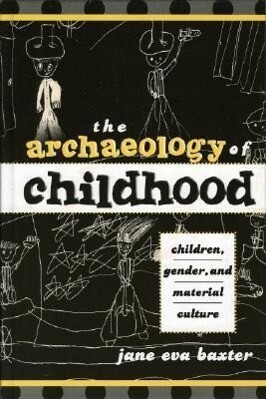
Zustellung: Do, 31.07. - Mi, 06.08.
Versand in 3-4 Wochen
VersandkostenfreiThe study of children and childhood in historical and prehistoric life is an overlooked area of study that Jane Baxter addresses in this brief book. Her timely contribution stresses the importance of studying children as active participants in past cultures, instead of regarding them mainly for their effect on adult life. Using the critical concepts of gender and socialization, she develops new theoretical and methodological approaches for the archaeological study of this large but invisible population.
Inhaltsverzeichnis
1. The Archaeology of Childhood in Context
Childhood in Anthropology
Childhood in Archaeology
The Importance of an Archaeology of Childhood
Chapter Organization
2. Theorizing Childhood in Archaeology
Introducing the Child's World
Children and Gender: Cultural Categories in Archaeology
Children as Active Participants in the Past
Moving forward: Socialization and the Study of Childhood
3. The Cultural Creation of Childhood: The Idea of Socialization
The Concept of Socialization: An Intergenerational Discourse
Agents of Socialization and the Imparting of Cultural Knowledge
Socialization in the Past
Socialization Across Cultures
4. Socialization and the Material Culture of Childhood
Multiple Meanings and Material Culture
Socialization in the Use of Material Culture: Toys and Playthings
Identifying Toys in Archaeological Contexts
Socialization in the Making of Material Culture: Apprenticeship and Situated Learning
Studying Apprenticeship and Learning in the Archaeological Record
5. Socialization, Behavior, and the Spaces and Places of Childhood
Children as a "Distorting Factor" in the Archaeological Record
Socialization and the Use of Space
Children at Play
Children at Work
Children and Space across Cultures
Children and Space in the Archaeological Record
Socialization, Space and Archaeology of Childhood
6. Socialization, Symbols, and Artistic Representations of Children
Depicting Childhood, Depicting Gender
Children at Work and at Play
Child Rearing and Parenting
Children as Cultural Symbols
7. Socialization, Childhood, and Mortuary Remains
What are we studying when we analyze mortuary remains?
Children as a Category in Mortuary Archaeology
Identifying Age Based Categories through Mortuary Remains
Childhood Health, Nutrition, and Mortality
Children and the Elucidation of Horizontal Social Categories
Children as Indicators of Vertical Social Status
Mortuary Monuments and Representations of Children
8. Themes and Lessons from the Archaeology of Childhood
Socialization, Gender, and the Cultural Construction of Childhood
Casting Children as Actors
Child, Family, Community, Society
All Archaeology is the Archaeology of Childhood
Bibliography
Index
Childhood in Anthropology
Childhood in Archaeology
The Importance of an Archaeology of Childhood
Chapter Organization
2. Theorizing Childhood in Archaeology
Introducing the Child's World
Children and Gender: Cultural Categories in Archaeology
Children as Active Participants in the Past
Moving forward: Socialization and the Study of Childhood
3. The Cultural Creation of Childhood: The Idea of Socialization
The Concept of Socialization: An Intergenerational Discourse
Agents of Socialization and the Imparting of Cultural Knowledge
Socialization in the Past
Socialization Across Cultures
4. Socialization and the Material Culture of Childhood
Multiple Meanings and Material Culture
Socialization in the Use of Material Culture: Toys and Playthings
Identifying Toys in Archaeological Contexts
Socialization in the Making of Material Culture: Apprenticeship and Situated Learning
Studying Apprenticeship and Learning in the Archaeological Record
5. Socialization, Behavior, and the Spaces and Places of Childhood
Children as a "Distorting Factor" in the Archaeological Record
Socialization and the Use of Space
Children at Play
Children at Work
Children and Space across Cultures
Children and Space in the Archaeological Record
Socialization, Space and Archaeology of Childhood
6. Socialization, Symbols, and Artistic Representations of Children
Depicting Childhood, Depicting Gender
Children at Work and at Play
Child Rearing and Parenting
Children as Cultural Symbols
7. Socialization, Childhood, and Mortuary Remains
What are we studying when we analyze mortuary remains?
Children as a Category in Mortuary Archaeology
Identifying Age Based Categories through Mortuary Remains
Childhood Health, Nutrition, and Mortality
Children and the Elucidation of Horizontal Social Categories
Children as Indicators of Vertical Social Status
Mortuary Monuments and Representations of Children
8. Themes and Lessons from the Archaeology of Childhood
Socialization, Gender, and the Cultural Construction of Childhood
Casting Children as Actors
Child, Family, Community, Society
All Archaeology is the Archaeology of Childhood
Bibliography
Index
Mehr aus dieser Reihe
Produktdetails
Erscheinungsdatum
18. Januar 2005
Sprache
englisch
Seitenanzahl
143
Reihe
AltaMira Press
Autor/Autorin
Jane Eva Baxter
Verlag/Hersteller
Produktart
gebunden
Gewicht
363 g
Größe (L/B/H)
225/143/8 mm
ISBN
9780759103313
Bewertungen
0 Bewertungen
Es wurden noch keine Bewertungen abgegeben. Schreiben Sie die erste Bewertung zu "Archaeology of Childhood" und helfen Sie damit anderen bei der Kaufentscheidung.













